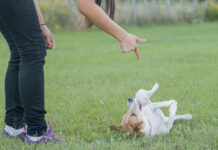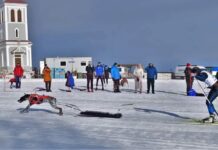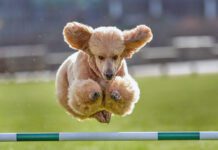[Updated February 5, 2019]
“All right!” I shout and we take off down the trail. The dogs’ heads are down and they are kicking up snow as they lean into their harnesses, pulling hard and running fast. On the other end of the leash, behind them, I begin skate-skiing, using my poles for stability and doing my best to create more speed. Through the woods, down hills, around corners, we fly. We are out skijoring on a blustery, cold, Montana winter day, under grey skies and on slick, fast snow. The day is filled with whoops, hollers, laughter, hot cocoa for me, and jerky for the dogs. By the end of the day, we all pile into the truck, exhausted, and oh-so-happy.
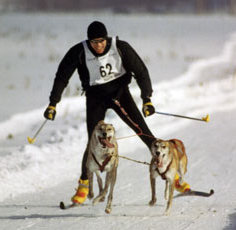
When the weather outside gets frightful and the snow begins to fly, getting out in it with your dog can be delightful. From winter sports such as skijoring, kicksledding, and mushing to mellower activities like snowshoeing or even a casual stroll, there is no need for you and your dog to be cooped up indoors all winter. With some knowledge, a bit of training, and the right gear, winter is easily transformed into an exciting time of year.
Winter Dog Sports
Most people have heard of mushing, but say “skijor” or “kicksled” and chances are you will get a blank stare. That is, unless you’re speaking with someone from a Northern European country or Alaska, where dogs were historically, and in some cases still are, used in everyday life for survival in harsh climates.
Literally meaning “ski-driving” in Norwegian, skijoring originated in Scandinavia and is a hybrid sport combining cross-country skiing and dog mushing. Perfect for the equipment minimalist, skijoring requires cross-country ski gear, a skijoring belt, a harness for your dog, and a towline to connect you to your dog.
Nordic breeds and multiple dogs are not required; any dog that loves to run can participate. Dogs weighing over 30 pounds with enough height to negotiate running in snow can skijor with ease and a single dog is all that is necessary. A thin coat does not eliminate a dog from the sport either; some of the top competing skijor teams include German Shorthaired Pointers (often donning outerwear, of course). An exhilarating sport, skijoring allows you and your dog to exercise together while enjoying the winter landscape.
First developed more than 150 years ago, kicksleds are prevalent today in small towns throughout Finland, Norway, and Sweden, and are used to get around slick side streets. Operating like a scooter, kicksleds glide swiftly on ice or compacted snow. Your dog is easily attached to a kicksled with a harness and towline for increased speed and great exercise. This sport is also less physically demanding for the driver.
Best for flat, icy surfaces, kicksleds don’t do well in deep, soft snow, or on steep terrain, so if hills are on your planned route, you’ll need to wear some good cleats or crampons, because the sleds have no brakes beyond foot dragging. Steering the kicksled is simple; you just twist the handlebars in the direction you want to go. Be aware, though, that your control is limited; your dog must respond to your voice commands for safety’s sake. The next time the streets are snow packed and you need to drop off last night’s movie at your neighborhood store, imagine grabbing your dog, your kicksled, and heading outside!
If you are looking for more adventure than can be had from scooting around the streets with your dog, and being pulled behind a team in the wilderness sounds more appealing, perhaps it’s time to give mushing a try. A team of 20 dogs averaging 75 pounds can exceed 20 miles an hour (or more on shorter sprints) and is capable of maintaining an average speed of 10 miles an hour.
In January 1925, an outbreak of diphtheria threatened to become a fatal epidemic in Nome, Alaska, prompting the recruitment of 20 drivers and 100 dogs to deliver a package of antitoxin serum from Anchorage to Nome. Due to temperatures averaging 50° below 0°, planes were ruled out for the expedition, but mushers made a heroic effort, with a relay of teams delivering the serum to Nome in less than five and a half days, ultimately saving the town. The 1,150-mile Iditarod race was created to commemorate that feat.
Mushing with your current team of dogs, which is perhaps smaller than 20, will require the most preparation of all the canine winter sports; mushing requires a great deal of equipment and know-how to get started. Fortunately, there are numerous books, websites, and magazines available to assist the beginning musher in locating the right equipment, supplies, and training materials.
Snowshoeing with your dog is an easier activity to enjoy on the slower end of the winter season spectrum. Picking up a pair of snowshoes can make an outing on a favorite trail or around your local park easier and more fun during the snowy months. Doing so with a belt, harness, and towline, connecting you to your dog, will increase your ability to negotiate the terrain and with greater speed. Aside from making sure that both you and your dog are physically fit to begin, snowshoeing requires no extra training time, very little equipment, and allows you and your dog to get a great workout. Many people progress from casual walks on snowshoes, to faster hikes, to snowshoe runs with their dogs over the course of a single season.
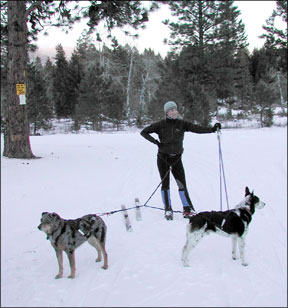
Preparing for Winter Outings with Dogs
As with any athletic pursuit, the key to preparing a dog for winter sports is to start out slowly, preventing injury and/or burnout. There are any number of training programs available (in books and DVDs) that offer guidance on building your dog’s strength and endurance. It particularly helps if you start teaching your dog to be comfortable with being attached to you and pulling a bit of weight before the ground gets slippery with ice or snow! Training should be positive, encouraging any desired behavior that your canine partner offers, since you and your dog work together as a team in most winter sports. The prerequisites, however, include teaching your dog to “gee” (turn right), “haw” (turn left), and “whoa” (that’s obvious!).
Once your dog has learned cues for turning and slowing, and is comfortable with pulling as a canine-human team, you can start working on physical conditioning. Vary your pace, following a fast workout with a slow fun run. Or do a long distance run followed by shorter, faster outings.
Vary training areas as well to reinforce your verbal cues, since dogs often tire of the same trail and come to anticipate turns. If you use the same trail every time you go out, start in the middle, run it backward, or stop in a different spot every time and reverse direction. Once your dog anticipates a turn and he “haws,” for instance, without your cue to do so, it’s time to change your route. Plus, taking a different route keeps training more mentally stimulating for both you and your dog.
Putting on miles is important, but so is rest. Spending quality time together without physical or mental requirements can go a long way in improving enthusiasm for a sport, while maintaining a close bond. Always keep an eye on your dog’s movement, and stop if he shows any sign of lameness, injury, or reluctance to go. Also monitor his joints (for range of motion and swelling) and appetite. If his attitude or aptitude ever begins to wane, take him to your veterinarian for a thorough health examination.
When asking your dog to perform at a more demanding physical level, a high quality diet is incredibly important. All athletes need more calories when in training and competition, especially in cold conditions, and your dog is no exception. Increasing the amount of calories and fat in the diet will probably be required; discuss specifics with your veterinarian to maintain the long-term health of your canine athlete. Making sure that your dog is adequately hydrated is just as important. Snow is not a sufficient substitute for water; bringing a supply of water along with you on your outings is a necessity.
Gear for Winter Dog Activities
While training is important for your dog, so, too, is finding the right gear to safely and comfortably enjoy the outdoors in winter. Snow between your dog’s foot pads can cause frostbite and lameness, and crusted snow and ice can easily cut his feet. Trim the excess hair from the footpads and toes of longhaired dogs; this will make it easier to remove ice and snow.
Better yet, use booties for the best foot protection. Don’t be disappointed if your dog high-steps around in protest when you put them on; most dogs resist booties at first, but they typically quickly desensitize to the footwear when a fun outing is on the horizon. A variety of windproof and waterproof coats for your dog are available on the market and worth looking into if your dog has a very short coat, doesn’t do well in cold temperatures, or you plan on making frequent stops during your outing.
Rather than your local pet supply store, look for active canine winter gear on skijoring or mushing websites, or in magazines and catalogs. I recommend shopping at outlets that specialize in equipment for human-canine athletic teams who participate in winter sports. Their equipment is usually field-tested in severe conditions – a good testimony to the durability and function of the products.
Due to the fringe nature of most of these sports, most companies that sell such specialized equipment are small businesses owned and operated by enthusiasts of these sports; these folks tend to welcome interest in the products they offer and will be incredibly helpful in guiding you to what you need. A few good sites to explore include:
skijorusa.com
scandiakicksled.com
sleddogcentral.com
ruffwear.com
Winter Safety First
Exercising out-of-doors in the winter can pose certain risks. Keep your dog and yourself safe by observing common sense, cold-weather guidelines:
■ Dogs, like people, are susceptible to hypothermia. Hypothermic animals should be warmed slowly. You can wrap a hypothermic dog in warm blankets or place towel-wrapped bottles filled with warm water next to his armpit and groin.
■ Watch for frostbite, especially in vulnerable areas such as ears, paw pads, tail, and groin. Signs include flushed and reddened tissues, white or grayish tissues, scaliness and possible shedding of dead skin, and evidence of shock.
■ Add heat packs and an emergency blanket to your first-aid kid.
■ Make sure your dog is wearing proper ID and/or a microchip identifier in case he gets separated from you on the trail.
■ Use caution if you and your dog are around frozen creeks, rivers, lakes, or streams. Staying dry is vital in extremely cold weather.
■ After your return home from a stroll on frozen city streets and sidewalks, rinse your dog’s paw pads to remove salt and any other de-icing agents that he may have encountered. You may also choose to apply a salve prior to and after your outing to protect against these substances, but keep in mind that it must be non-toxic and consumable, because chances are high it will be licked off.
No Dog Left Inside
Whatever winter activity you choose, before you head out, make sure that the destination area of your choice welcomes dogs. Be respectful of other users and wildlife, keeping your dog under physical or voice control at all times. This prevents conflict with other dogs and recreationists, while protecting wildlife, who have little reserve in winter for the added stress of being chased.
Whether you swoosh down the trail with your dog pulling ahead, or head out on your city street for a casual stroll, winter truly is a wonderful time of year for both you and your dog.
OUTDOOR WINTER ACTIVITIES FOR DOGS: OVERVIEW
1. If you live in a snow zone, try a snow-based recreational activity with your dog!
2. Contact other canine winter sport enthusiasts and ask to tag along on their outings. Most people are eager to share their knowledge and even gear with enthusiastic newcomers.
3. Use caution when you and your dogs are around frozen creeks or lakes. Staying dry is vital in extremely cold weather.
Kathryn Socie-Dunning is a freelance writer in Missoula, Montana. When she is not writing, she is out on the trail hiking, running, and when the snow is flying, skijoring with her dogs.



